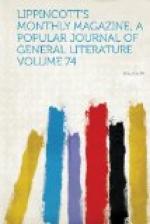The valley grew wider and spread into a great bare plain, still bordered with pine-sprinkled bluffs, through which the river dodged about without any apparent reason, and wherever it went the trees followed. Before we came in sight of the agency we were met by several officers and traders, glad of a little change of society. They conducted us to our camp on a pleasant rising ground about a mile from the agency, overlooking the cavalry and infantry camps in front and rear. It is a wild, lonely, fascinating place, this White River Valley, shut out from the world by its castled bluffs, though should we climb them we should only find another desert. We dined under a bower of pine boughs beside our tents, that served for a parlor. In the evening everybody called to see us, including the only two ladies in the place, wives of the traders, who looked too delicate to bear the hardships of the wilderness. Perhaps the hardships are not great, but the loneliness must be terrible in the long, long winters.
The next day we drove over to the agency, eager to see the Indian dance that had been promised us. The place consists of several government and private buildings surrounded by a stockade. When we arrived a large number of Indians were already there, mostly squaws and children, mounted on ponies and dressed in their gayest blankets and embroideries. Their ponies are very pretty, small, gracefully-formed horses, not clumsy as we had expected. The mantles of the squaws were of deer-skin, but covered entirely with beads, the groundwork of deep sky-blue ones, with gay stiff figures in brilliant colors. They were gracefully cut, somewhat like a “dolman,” and had a rich, gorgeous effect in the crowd. Most of them wore necklaces of “thaqua”—the quill-like white shell which is brought from the Pacific, and serves them for small change—and heavy earrings of the same shells, a quarter of a yard long. Their ears were slit from top to bottom to hold these great earrings: sometimes they wore two pairs, with heavy mother-of-pearl shells at the end of each. The necklaces covered the whole chest, like a bib or a breastplate. The parting of their long black hair was painted red, and their cheeks daubed with red, yellow and blue. Most of them had flat faces and flat noses: very few were in the least good-looking. Hundreds were waiting outside the gates, among them some half-breed boys.
Soon the braves began to come in. With a glass we could see great numbers of them winding out of the hills from their hidden camps, well mounted and flashing with bright arms and gay trappings. It was a strange, wonderful scene of motion and color, with the gray, unchangeable desert and the pale walls of the buttes for a background. The men came crowding, tearing in at a great pace, and soon we could see the dancing-party dashing along in all their feathers and war-paint, an inconceivably wild, savage cavalcade. On they rushed, beating a great drum in solemn cadence,




